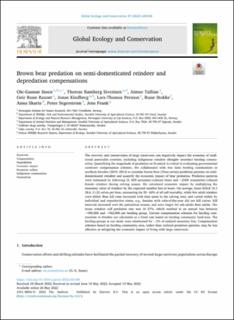| dc.contributor.author | Støen, Ole-Gunnar | |
| dc.contributor.author | Sivertsen, Therese Ramberg | |
| dc.contributor.author | Tallian, Aimee Grace | |
| dc.contributor.author | Rauset, Geir Rune | |
| dc.contributor.author | Kindberg, Jonas | |
| dc.contributor.author | Persson, Lars-Thomas | |
| dc.contributor.author | Stokke, Rune | |
| dc.contributor.author | Skarin, Anna | |
| dc.contributor.author | Segerström, Peter | |
| dc.contributor.author | Frank, Jens | |
| dc.date.accessioned | 2022-08-05T10:29:16Z | |
| dc.date.available | 2022-08-05T10:29:16Z | |
| dc.date.created | 2022-06-24T10:51:08Z | |
| dc.date.issued | 2022 | |
| dc.identifier.citation | Global Ecology and Conservation. 2022, 37 . | |
| dc.identifier.issn | 2351-9894 | |
| dc.identifier.uri | https://hdl.handle.net/11250/3010322 | |
| dc.description.abstract | The recovery and conservation of large carnivores can negatively impact the economy of traditional pastoralist societies, including indigenous reindeer (Rangifer tarandus) herding communities. Quantifying the magnitude of predation on livestock is critical to evaluating governmental carnivore compensation schemes. We collaborated with two Sami herding communities in northern Sweden (2010–2012) to examine brown bear (Ursus arctos) predation patterns on semidomesticated reindeer and quantify the economic impact of bear predation. Predation patterns were estimated by following 21 GPS proximity- collared bears and ~2500 transmitter-collared female reindeer during calving season. We calculated economic impact by multiplying the monetary value of reindeer by the expected number lost to bears. On average, bears killed 10.2 [8.6, 11.5] calves per bear, accounting for 39− 62% of all calf mortality, while few adult reindeer were killed. Bear kill rates increased with time spent in the calving area, and varied widely by individual and reproductive status, e.g., females with cubs-of-the- year did not kill calves. Kill intervals increased over the parturition season, and were larger for sub-adults than adults. The mean reindeer calf predation rate was 16–27%, which resulted in an annual loss between ~€50,000 and ~€62,000 per herding group. Current compensation schemes for herding communities in Sweden are calculated as a fixed rate based on herding community land-area. The herding groups in our study were reimbursed for ~2% of realized monetary loss. Compensation schemes based on herding community area, rather than realized predation patterns, may be less effective at mitigating the economic impact of living with large carnivores. Compensation Depredation Economic impact Proximity collars Indigenous communities Pastoralism | |
| dc.language.iso | eng | |
| dc.title | Brown bear predation on semi-domesticated reindeer and depredation compensations | |
| dc.title.alternative | Brown bear predation on semi-domesticated reindeer and depredation compensations | |
| dc.type | Peer reviewed | |
| dc.type | Journal article | |
| dc.description.version | publishedVersion | |
| dc.subject.nsi | VDP::Zoologiske og botaniske fag: 480 | |
| dc.subject.nsi | VDP::Zoology and botany: 480 | |
| dc.source.pagenumber | 9 | |
| dc.source.volume | 37 | |
| dc.source.journal | Global Ecology and Conservation | |
| dc.identifier.doi | 10.1016/j.gecco.2022.e02168 | |
| dc.identifier.cristin | 2034762 | |
| dc.relation.project | Andre: Swedish government (Jo2007/813) | |
| cristin.ispublished | true | |
| cristin.fulltext | original | |
| cristin.qualitycode | 1 | |
